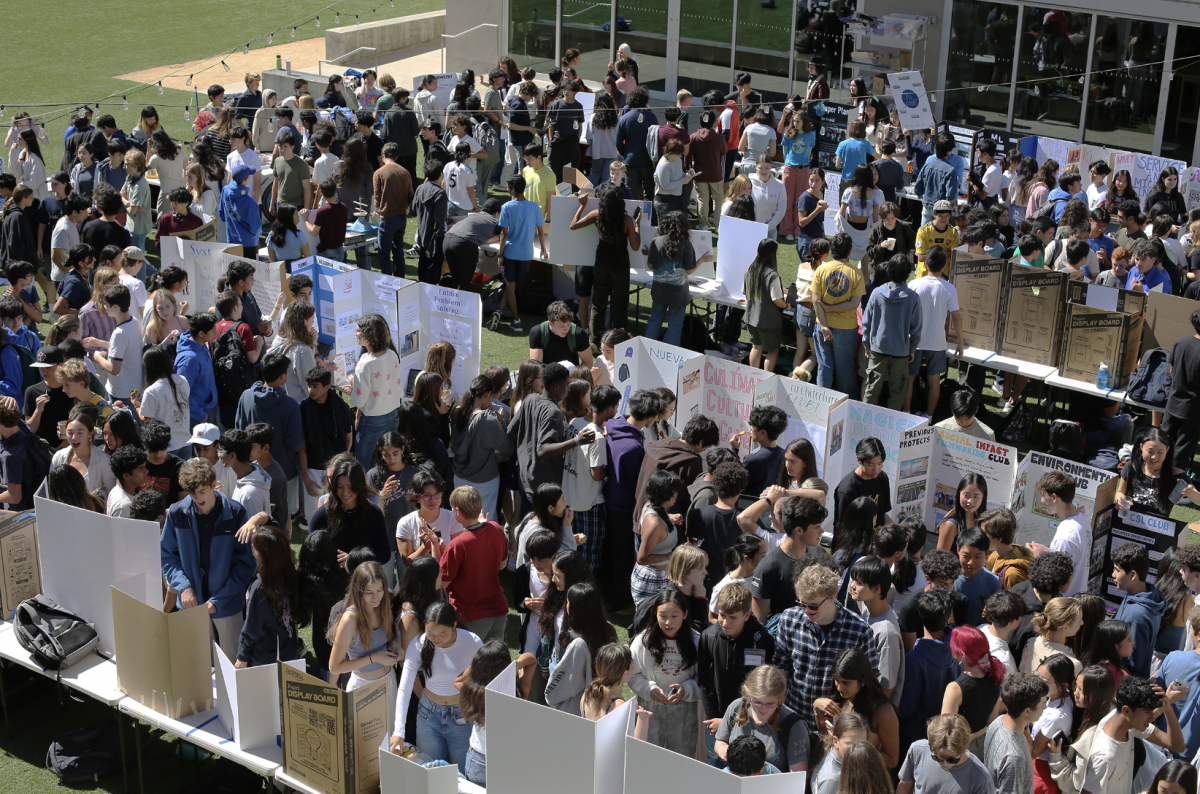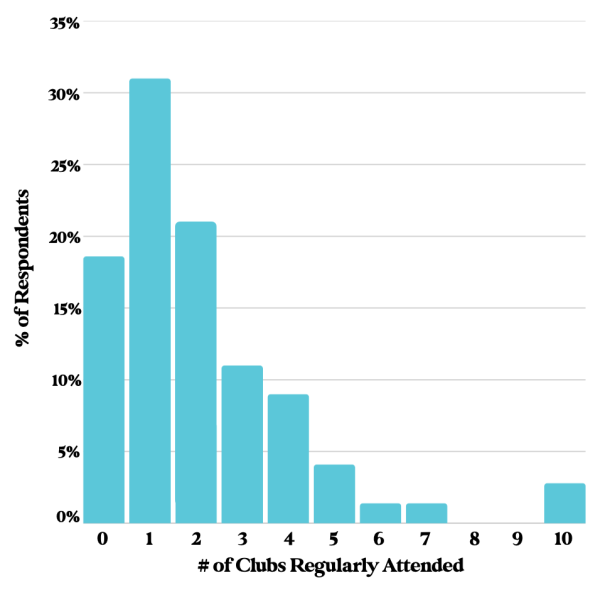
Lupe Ruiz
From a bird’s eye, the Rosenberg has turned from a lawn into a swarm, with students slowly rotating around dozens of tables. The September sun is bearing down on the posters, snacks, and eager club leads trying to get you on their mailing list: no promises or obligations, just a wave of opportunities.
For freshmen, the Clubs Fair is a showcase of the manifold possibilities of the Upper School, and each club is eager to bring newcomers up to speed. But while freshmen are able to learn each club’s interests and goals, they can never definitively know the club’s life expectancy.
A recent anonymous survey of 145 Upper School students conducted by The Current in conjunction with the Statistics and Data Science electives shines a light on that question.
Based on the survey’s self-reported data, the average Nueva student signed up for 5.3 clubs this fall with the intention of regularly attending 3.6 of them. By the end of the year, however, the average student attends only 2.1 clubs on a regular basis.

When it comes to why students choose to sign up for the clubs they do, students cited various reasons:
“[I] joined clubs because I thought they would be a fun place to expand my hobbies,” said one sophomore.
“[My] main reason for joining was because friends ran them,” said another sophomore.
“I lead all the clubs that I’m a part of! Maybe it says something that I’m not a part of any clubs that I don’t lead,” said a junior.
“Other than those I already knew I would sign up for, all the new clubs I joined were just ones that bribed me with food,” Etienne Y. ’28 said.
“I stumbled in on a club one day and felt guilty about not returning, so I kept coming,” another freshman admitted.
On Sept. 11 this school year, 44 new clubs debuted for the first time at the Clubs Fair. Clubs are born relatively easily: filling out a single form and setting up a table at the fair is often all you need to get dozens of members. But the death of a club is far more complicated.
While many clubs cease to be active within a single school year, others go through much slower processes of rise and fall.
The demographic trends of countries are often depicted using a population pyramid. Countries with bottom-heavy pyramids can anticipate future growth and a large working-age population. When the pyramid is inverted, the country faces an eminent wave of demographic and economic decline.
Clubs can be understood in a similar way. Those that retain large groups of underclassmen will become new staples of the Nueva experience, while clubs maintained by a small group of seniors or juniors are likely to vanish.
What are clubs doing to address their long-term futures? What differentiates the startups from the institutions, the old from the new, and the thriving from the withering? Looking to a wide variety of clubs for examples, certain commonalities of the club experience at Nueva emerge.
DATAS
DATAS (Discussions and Talks About Science), the producer of Science Friday, may well be one of the oldest clubs at Nueva. Spearheaded by former biology teacher Luke De in 2017, it has become not just a club but closer to an institution.
After De, who had encouraged his students to join and present, left Nueva in 2023, the pool of potential presenters for the club started to dry up. Attendance at weekly Science Friday presentations has fallen for two years straight.
Co-lead Andy M. ’26 sees the long-term trouble for DATAS as emerging, in part, from an overall tendency to prefer starting new clubs over maintaining existing ones.
“There’s an emphasis on being a leader,” Andy argued. “People would rather say they co-founded and led a club versus essentially being inducted into an already established one.”
Max K. ’26, who is in leadership for DATAS, Queer Student Union, and Robotics, has seen another trend across the groups he leads.
“There are fewer freshman sign-ups. I don’t know if that’s a cultural shift from previous grades or if it’s that our current crop of upperclassmen are failing to lead these clubs,” Max said.
This year, the Science Friday process has changed in response to the increasing pressures of maintaining the club. The review system for presenters has been streamlined, with Review Pairs replacing the large, hard-to-schedule Review Teams. Club leadership has focused on increasing outreach to potential members and presenters.
But if institutional clubs such as DATAS continue to fade in favor of transient startups, their unique value will fade with them.
“Often the events that these longer running clubs put on are more high quality, more fleshed out, and have more experience behind them,” Andy said. “It’s very sad for me to see these clubs, which I love dearly, dying off.”
Environmental Club
Environmental Club mirrors DATAS in terms of on-campus prominence and sheer longevity, though it faces a sunnier outlook for the near future.
The club’s membership is above average, and drew 22 people to its final meeting of the year on May 21. Its presence can be felt well beyond its meeting spot in Room 1105. In addition to the annual Eco-Action Raiser and Earth Day WOWs, the club expanded its programs this year with an inaugural Waste Audit and the start of a Pre-K Partnership.
For club co-lead Justin C.-B. ’26, the variety of opportunities the Environmental Club provides is part of the appeal.
“I think we enable people to work on what’s interesting to them. We have people who are focused on policy, on reducing waste, or on programs like working with the Lower Schoolers,” Justin said.
While weekly meetings regularly include presentations or guest speakers, the main appeal for many members is the work done outside of the meeting time.
“One reason why we get a lot of club retention is just because the work we do is impactful and rewarding,” Justin added.
Systema
Systema, which partners with local under-resourced schools to provide STEM education opportunities, was among the 44 new clubs founded this past year. The club boasts around 20 active members according to Wendy E. ’26, who co-founded the club with Isabel Q. ’26 and Anika G. ’26.
“Isabel and I both came from pretty big public schools that didn’t have STEM resources,” Wendy said. “Being at a place like Nueva now gives us so many resources and opportunities that we could share with other students.”
Systema, which holds active partnerships with Peninsula Bridge and three local middle schools, is not the only externally-focused, mission-driven club at Nueva. But why do these student-run organizations choose to take the form of a club?
“Even though it’s a large idea of bridging the gap between the gap of underprivileged students and STEM, an organization is a lot more intimidating to join, while a club is much more accessible,” Wendy explained.
Youth Design Impact
Youth Design Impact, which provides free graphic design assistance to non-profit organizations, was. The club’s attendance has stabilized at three students, down from six at the first meeting in September.
Grace B. ’26, who founded the club as an extension of her sophomore quest, doesn’t view the small membership as an issue.
“I saw how design can help how people feel towards their organization, so I started the club because I couldn’t do it alone,” Grace said. “I expected the membership to whittle over time.”
This year, the club has worked with 15 non-profits, saving them over $60,000 based on the volunteering website Catchafire’s cost estimates of hired graphic design.
Like many young clubs, Youth Design Impact faces an uncertain future upon its founder’s graduation. For Grace, the club’s continuation beyond next year will be up to its junior members.
“It’ll be up to them. Even if it stops being a formal club, I know it’s something I want to keep doing.”
Board Game Club
Board Game Club, founded in 2019, is currently led by Liam P. ’26. The club draws a group of five to ten people, almost exclusively juniors, to its Friday afternoon meetings.
The time a club meets is often vitally important to its long-term future, as Liam can attest.
“10th grade was a low low, and then 11th grade got a lot better just because of the timing,” Liam said. “It was the difference between doing it during Tuesday lunch versus after school on a Friday.”
With extracurriculars taking up students’ afternoons and advisory filling two lunches a week, Tuesday lunch has long been a crowded time period for clubs to meet. With so much competition at a single time, club attendance is inevitably fractured across the board.
Cheese Club
While most clubs orient themselves around a common interest or mission, others—such as the Sandwich Club or Cheese Club—serve a different purpose.
These clubs offer a social hall to spend time in, regardless of whether or not you’re eating the cheese.
Nonetheless, the two-year-old Cheese Club has gone on hiatus this semester, though its leadership expects it to return in some form next year.
“We just got swamped with work,” said club lead Max K. ’26. “Cheese Club existed because it was not a huge burden on myself and the other leads to run and it brought us joy. Once people stopped showing up as frequently, and once it started becoming more and more of a burden to run, we needed to reframe it.”
Cheese Club faced the additional challenge of having moved its time from Wednesday afternoons to the coveted Tuesday lunch spot, which strained turnout.
Additional Research by Neel G., Brooks W., and Evan W.